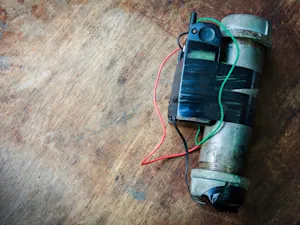
The Murder Hollywood Can't Forget
The morning of Jan. 15, 1947, seemed ordinary enough in Los Angeles' Leimert Park. A young mother, out for a walk with her child, stopped in her tracks when she saw what she thought was a mannequin tossed on an empty lot. What lay before her wasn't a mannequin at all — it was the mutilated body of Elizabeth Short. That gruesome discovery would kickstart one of Hollywood's darkest and most enduring mysteries.
Who Was Elizabeth Short Before She Became the Black Dahlia?
Before she became a household name for all the wrong reasons, Elizabeth Short was a small-town girl with big dreams. Born on July 29, 1924, in Hyde Park, Massachusetts, she grew up with four sisters and a father who faked his own death after the stock market crash. When she was 18, Short tried to reconnect with him in California, but the reunion didn't last long.
Her journey to Hollywood wasn't a straight shot. Short bounced between Florida and Massachusetts, and eventually made her way to Los Angeles in 1946, hoping to make it as an actress. She charmed people wherever she went, but her life remained a mystery even to her closest friends.
Vince Carter, a former police officer, stated, "Her roommates, the bartenders, and the hotel clerks all came up with the same story. She was secretive — never one to confide. She never said what she was really doing, or who she was really going out with, or where she was really going," according to the true crime book "The Black Dahlia: Shattered Dreams," as reported by PEOPLE. Despite her struggles to stay afloat financially, she always seemed to find a way.
The Chilling Crime Scene That Stopped Los Angeles Cold
When police arrived at the lot where Short's body had been dumped, they found a scene straight out of a horror film. Her body had been cut in half at the waist with precision, drained of blood, and posed with chilling deliberation. Her arms were stretched above her head, her legs spread apart, and her face bore a grotesque slash from ear to ear.
Nearby, police found a bloodstained cement bag, likely used to transport her body. But there were no signs of blood at the scene, which meant Short had been killed elsewhere. An autopsy revealed the official cause of death was a cerebral hemorrhage caused by repeated blows to the head.
Sensational Headlines and a Killer Who Played Games
The press descended on the case like vultures, dubbing her "The Black Dahlia" after the noir film "The Blue Dahlia" and her dark clothing. Tabloids painted Short as a femme fatale, spinning stories about her romantic escapades and mysterious lifestyle. The Los Angeles Examiner even misled her mother, claiming Short had won a beauty contest, only to pry personal details before delivering the horrific news, as reported by Goldenglobes.com.
On Jan. 24, 1947, the media frenzy intensified when an envelope arrived at the Los Angeles Examiner. Inside were Short's birth certificate, photos, and business cards, along with a letter assembled from newspaper clippings. "Here is Dahlia's belongings," it read, according to GoldengGlobes.com. The items had been wiped clean with gasoline, just like her body, making it impossible to lift fingerprints. This chilling gesture confirmed what everyone feared — the killer wanted the spotlight.
The Suspects and Theories That Keep the Case Alive
The Los Angeles Police Department chased hundreds of leads, but every promising suspect seemed to slip through their fingers. Among them was Dr. George Hodel, a gynecologist with a flair for the dramatic and a dark past. Hodel's son Steve happened to be an LAPD detective, and he set out to prove that his father was indeed the one who killed the Black Dahlia.
According to Steve Hodel's bestselling book "Black Dahlia Avenger: A Genius for Murder," Steve uncovered evidence implicating his father, including a taped conversation in which George allegedly said, "Supposin' I did kill the Black Dahlia. They couldn't prove it now. They can't talk to my secretary anymore because she's dead. Killed her. Maybe I did kill my secretary," as reported by PEOPLE. The LAPD didn't file charges, and George Hodel left for the Philippines, living out his days far from the shadow of suspicion. That recording, along with other pieces of evidence, such as witnesses describing George as Short's boyfriend and his training as surgeon, kept his son convinced of his guilt until after George's death in 1999.
Other theories ranged from Hollywood elites covering up their secrets to mob connections. Author Piu Eatwell, in the book "Black Dahlia, Red Rose," even suggested Short may have been killed in a seedy motel room after rejecting advances from nightclub owner Mark Hansen, according to Goldenglobes.com. Yet, no one could provide the definitive answer.
The Enduring Haunt of the Black Dahlia
Elizabeth Short's unsolved murder has captivated generations, not just for its brutality but for its tragic human story. She was more than a tabloid caricature; she was a young woman with dreams and fears, a life stolen before it could truly begin. While her killer remains unknown, her memory continues to loom over Los Angeles like a ghost, a reminder of the city's darkest undercurrents.
The Black Dahlia case remains cold, but the fascination burns on, fueling books, films, and endless speculation. Somewhere, the truth waits to be uncovered. Until then, Elizabeth Short's story remains a chilling testament to how fame, even in death, can never escape tragedy.
References: Who Killed the Black Dahlia? Revisiting Elizabeth Short's Unsolved Murder 78 Years Ago Today — and Why a Retired Detective Believes His Father Committed the Crime | Forgotten Hollywood: The Mystery of the Black Dahlia Killing























